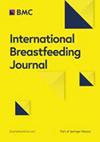夏威夷原住民的产前母乳喂养意愿:从出生到产后六个月期间母乳喂养的预测因素
IF 2.8
2区 医学
Q1 OBSTETRICS & GYNECOLOGY
引用次数: 0
摘要
夏威夷原住民(NH)的非传染性疾病发病率特别高,而夏威夷原住民婴儿的母乳喂养比例是夏威夷州所有民族中最低的。本研究的目的是在对夏威夷原住民母婴的研究中,探讨母乳喂养(HMF)的开始和持续时间的生物、社会经济和社会心理决定因素。参与本研究的样本包括 85 个正在参与一项大型前瞻性研究的 NH 母婴二人组。由于 COVID-19 大流行,母婴的招募工作被推迟。招募工作从 2020 年 11 月开始,一直持续到 2022 年 4 月。调查问卷在婴儿出生、产后两个月、四个月和六个月时发放。问卷内容涉及母婴特征和婴儿喂养方式。研究进行了描述性统计、比较分析和多元逻辑回归测试。大多数参与研究的母亲年龄在 31 至 35 岁之间,受过一些大学或更高的教育,有工作,并且是多胎妊娠。大多数婴儿在每个时间点都接受了 HM(出生时 94%,产后两个月 78%,产后四个月和六个月 76%)。与开始接受 HMF 和持续时间明显相关的因素包括:产前对 HMF 的意向、母亲的受教育程度、参与妇女、婴儿和儿童特别补充营养计划 (WIC) 的情况以及接受补充营养援助计划 (SNAP) 的情况。研究发现,产前的 HMF 意愿是出生时(aOR = 64.18,95% CI 2.94,1400.28)和产后两个月(aOR = 231.55,95% CI 2.18,2418.3)HMF 的有力预测因素。未参与 WIC 的参与者在产后四个月时更有可能出现 HMF(aOR = 6.83,95% CI 1.01,46.23)。这项研究支持现有的证据,即产前的 HMF 意愿和较高的产妇教育程度是 HMF 的积极预测因素。研究发现,参与 WIC 和接受 SNAP 与 HMF 呈负相关,这表明需要更多针对不同文化背景的支持。需要开展进一步的研究,以缩小与新罕布什尔州 HMF 决定因素相关的知识差距。本文章由计算机程序翻译,如有差异,请以英文原文为准。
Prenatal intention to human milk feed in the native Hawaiian population: predictors of any human milk feeding from birth to six months postpartum
Rates of non-communicable diseases are disproportionately high among Native Hawaiian (NH) people, and the proportion of NH infants being fed human milk (HM) is the lowest among all ethnicities within the state of Hawaiʻi. The aim of this study was to explore biological, socio-economic, and psychosocial determinants of the initiation and duration of human milk feeding (HMF) among a study of NH mothers and infants. A sample of 85 NH mother-infant dyads who were participating in a larger prospective study were involved in this research. Recruitment for the parent was delayed due to the COVID-19 pandemic. Recruitment started in November 2020 and continued until April 2022. Questionnaires were distributed at birth, two-months, four-months, and six-months postpartum. Questionnaires addressed topics relating to maternal and infant characteristics and infant feeding practices. Descriptive statistics, comparative analysis, and multivariate logistic regression tests were conducted. The majority of participating mothers were aged between 31 and 35 years, had some college education or more, were employed, and multiparous. The majority of infants were receiving HM at each timepoint (94% at birth, 78% at two-months postpartum, and 76% at four and six-months postpartum). Factors found to be significantly associated with HMF initiation and duration were prenatal intention to HMF, maternal educational attainment, Special Supplemental Nutrition Program for Women, Infants, and Children (WIC) participation, and Supplemental Nutrition Assistance Program (SNAP) recipiency. A prenatal intention to HMF was found to be a strong predictor of HMF at birth (aOR = 64.18, 95% CI 2.94, 1400.28) and at two-months postpartum (aOR = 231.55, 95% CI 2.18, 2418.3). Participants not involved with WIC were more likely to be HMF at four-months postpartum (aOR = 6.83, 95% CI 1.01, 46.23). This research supports existing evidence that prenatal intention to HMF and higher maternal educational attainment are positive predictors of HMF. WIC participation and being a SNAP recipient were found to be negatively associated with HMF which suggests a need for more culturally tailored support. Further research is required to reduce the gap in knowledge related to the determinants of HMF in NH.
求助全文
通过发布文献求助,成功后即可免费获取论文全文。
去求助
来源期刊

International Breastfeeding Journal
Medicine-Obstetrics and Gynecology
CiteScore
6.30
自引率
11.40%
发文量
76
审稿时长
32 weeks
期刊介绍:
Breastfeeding is recognized as an important public health issue with enormous social and economic implications. Infants who do not receive breast milk are likely to experience poorer health outcomes than breastfed infants; mothers who do not breastfeed increase their own health risks.
Publications on the topic of breastfeeding are wide ranging. Articles about breastfeeding are currently published journals focused on nursing, midwifery, paediatric, obstetric, family medicine, public health, immunology, physiology, sociology and many other topics. In addition, electronic publishing allows fast publication time for authors and Open Access ensures the journal is easily accessible to readers.
 求助内容:
求助内容: 应助结果提醒方式:
应助结果提醒方式:


